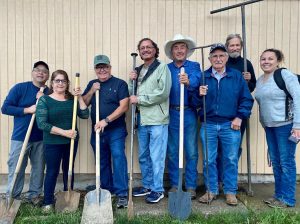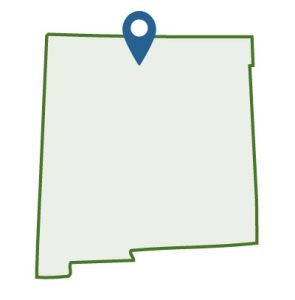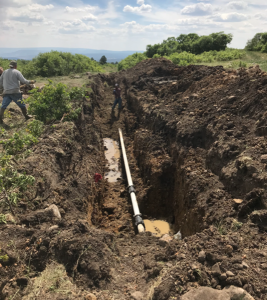
By Elliott Bochstein, RCAC staff writer
Perched atop a mesa in northern New Mexico’s Rio Arriba County, the small village of Canjilon is a living testament to the deep-rooted heritage of its community. Home to nearly 300 residents, primarily of Hispano and Indigenous descent, Canjilon’s roots stretch thousands of years, during which the Pueblo, Apache, and Navajo peoples have called the surrounding lands home.
Life here is tied closely to the land. Most residents rear livestock, hunt, and cultivate hay, while the nearby Carson National Forest and scenic Canjilon Lakes attract campers and recreation-seekers from across the region. Although it’s just 100 miles from the state capital, the median household income in Canjilon is $42,218 — about 68% of that in Santa Fe.

Water scarcity has always been a defining challenge in high desert communities, with sparse population density and modest financial resources compounding the problem. However, in recent years, prolonged drought and unpredictable climate shifts have nudged the village’s already vulnerable water supply and vital infrastructure toward a tipping point.
Villages like Canjilon historically rely on acequias, communal irrigation systems reflecting centuries of intertwined traditional ecological knowledge. The term ‘acequia’, rooted in Arabic, evolved in Spain under Moorish influence. By the 16th century, Hispano settlers integrated this method with Puebloan Indigenous waterways. Some 700 to 800 acequias crisscross northern New Mexico’s rural and urban areas, sustaining crops, replenishing groundwater, and nurturing diverse ecosystems.
By 1961, the village’s needs evolved beyond purely acequia-based allocation to the Canjilon Mutual Domestic Water Consumers Association (MDWCA). Over the years, the association expanded its reach from 25 to 174 connections. This growth was conditioned by challenges like fluctuating source water intake, seasonal shifts, declining lake levels, turbidity and persistent infrastructure maintenance needs.
State Senator Leo Jaramillo told RCAC Network News, “Canjilon is always looking at ways to improve their water infrastructure with the best interest of the community at the forefront. They are committed to ensuring their community is connected to water, New Mexico’s most valuable resource.”
Founding operator Albert Martinez and the association’s dedicated board work according to a clear principle: “When it breaks, we fix it – rain or shine!” This unyielding commitment to their community and infrastructure paved the way for an alliance with Rural Community Assistance Corporation(RCAC).
For nearly 15 years, RCAC and Canjilon have maintained a strong partnership. By offering technical support and unlocking federal, state and regional funding opportunities, RCAC enables small rural, underserved and Indigenous communities to achieve long-term water sustainability. “I encourage other water associations to work with RCAC, they’re very helpful and we can call on their help whenever we need,” said Martinez.

As both a Canjilon native and rural development specialist at RCAC, Hannah Whittaker has a keen grasp of the village’s challenges. She sees the association’s strength as a reflection of its board’s diverse skills in fields like soil and water conservation, forestry and accounting.
“Albert basically built this water system and he’s very savvy in terms of funding applications and politics,” Whittaker said, emphasizing the association’s outsized homegrown capacity. “The rest of the board also have solid backgrounds relevant to water systems.”
Despite their expertise, Canjilon MDWCA recognizes the necessity for collaboration — especially as ongoing challenges drain their resources both financially and tangibly.
“We have nearly five miles of three-inch PVC line leaking everywhere right now,” explained Martinez. “We’re losing more water than we’re selling.”
Seeking a sustainable future, the association teamed up with the Army Corps of Engineers to revamp the ailing infrastructure through an eight-stage project to replace and relocate its distribution system. With just the first three phases priced at $2 million, the association had to secure $550,000 in matching funds to get the project started. Even after dedicated fundraising, they faced a shortfall of nearly $150,000. To navigate this challenge, the board turned to RCAC.
Together, RCAC environmental staff and the board organized a village fiesta, Fiesta en Canjilon, its centerpiece a comprehensive presentation detailing the community’s infrastructure needs. Sen. Jaramillo and State Representative Susan Herrera attended the event. RCAC and the association crafted the presentation, ensuring it emphasized how small state contributions could potentially unlock over $2 million in federal funds.
“When I began working on the presentation, I had my own plan,” Whittaker said. “But Albert had a different vision – he wanted to recap every event in the system’s history, which is great! Our role is to take their lead and support their capacity, not detract from it.”
The presentation not only informed but actively engaged guests and officials, emphasizing the project’s urgency and the critical role they each would play. “Without RCAC we would not have been able to develop the presentation,” Martinez said.
Beyond the slides and figures, the Fiesta en Canjilon showcased the village’s unity and shared aspirations. Attendees enjoyed enchiladas with green chile and other local fare while a regional band serenaded them with traditional and contemporary tunes.
Following the event’s success, Canjilon MDWCA and RCAC deepened their collaboration with Sen. Jaramillo and Rep. Herrera. Together, they’re diligently working to address the funding gap, exploring diverse options and seeking new federal grants to ensure the project proceeds. RCAC remains committed to working alongside the village to overcome technical hurdles and ensure Canjilon has a water-secure and prosperous future.
Sen. Jaramillo lauds RCAC’s efforts to turn rural New Mexico communities’ aspirations into tangible outcomes.
“Canjilon’s goals become a reality with the help of partners like RCAC stepping in to lend a helping hand,” said Sen. Jaramillo. “For that, I’m very thankful.”
Also in this issue of Network News
RCAC Interview: Julia Hnilicka, Alaska USDA Rural Development Director
In this issue, we speak with Julia Hnilicka, State Director for USDA Rural Development-Alaska. Hnilicka was born and raised in the rural Alaskan village of Nenana, where she has spent most of her life. Her upbringing as the child of a tugboat captain and an educator has provided her with a firsthand understanding of the complex issues confronting rural households.
Read our interview with Julia Hnilicka
